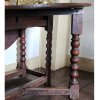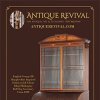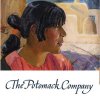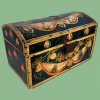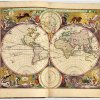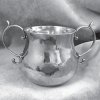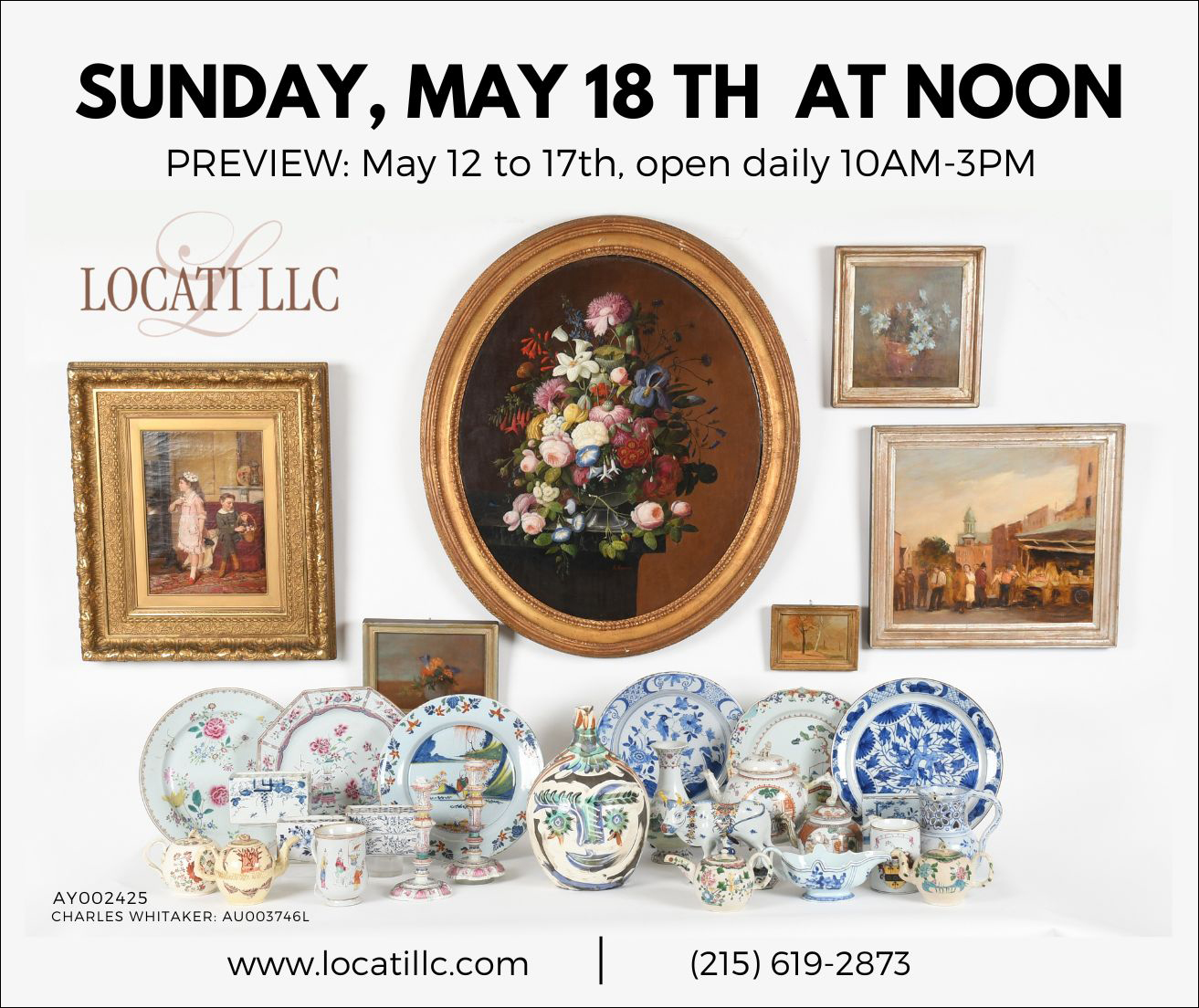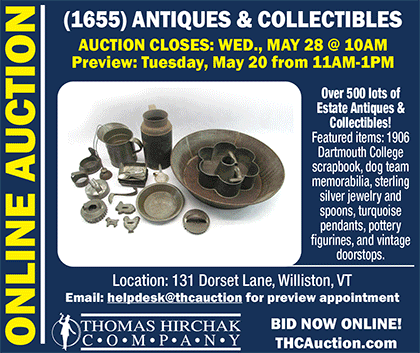Quinn's Launches New Name and Venue
September 26th, 2015
Quinn’s Auction Galleries-Central Virginia, Troy, Virginia
Photos courtesy Quinn’s Auction Galleries-Central Virginia
Quinn’s Auction Galleries-Central Virginia conducted its inaugural furniture and decorative arts catalog sale on September 26. It was an occasion to introduce the firm’s new location as well as its new name. Quinn’s has leased a large building on U.S. Rt. 250 in Troy, Virginia, just east of Zion Crossroads between Charlottesville and Richmond. The new space appears to lend itself nicely to the auction business, with a large open salesroom as well as ample display and storage areas. The facility is, however, a work in progress. When I arrived for the sale, Matthew Quinn was busily unwinding and installing electrical and sound system wiring and speakers. Paul Quinn told me that there were still a few issues to iron out with the county but that everything was moving along nicely. Signage was not yet installed, but none of the patrons appeared to have had any difficulty finding the site.
 This was also the first sale conducted under the new name of the firm, formerly Quinn & Farmer Auctions, Charlottesville. The Central Virginia component of the Quinn’s group will operate as a stand-alone entity conducting a calendar of both cataloged and “treasure” sales. Skip Usry will be the manager and day-to-day face of the Central Virginia firm.
This was also the first sale conducted under the new name of the firm, formerly Quinn & Farmer Auctions, Charlottesville. The Central Virginia component of the Quinn’s group will operate as a stand-alone entity conducting a calendar of both cataloged and “treasure” sales. Skip Usry will be the manager and day-to-day face of the Central Virginia firm.
Following the sale Usry commented that he was very pleased overall with this first sale. He stated, “I have always believed that central Virginia is a fantastic venue for bigger pieces of furniture, and it was nice to see that bear out.” He went on to say, “Several Richmond buyers commented on the convenient location of our new building.”

This Federal sideboard is southern and dates from the 18th century. The piece has mahogany end veneers, with yellow pine secondary woods. The outset center section features two drawers over two doors. The side sections display outward-curved doors. The sideboard is raised on square tapered and cuffed legs. The drawer and door fronts as well as the outward faces of the legs are decorated with string inlay. The piece measures 39" x 72" x 21¼" and exhibits an old refinished surface and losses to the veneer. The Federal sideboard sold for $1416 (est. $800/1200).

This lot was listed simply as a 19th-century field desk. It became the object of considerable interest from several Internet and telephone bidders. The desk is constructed of mahogany, rosewood, and tiger maple. When closed, it displays a narrow profile, standing on a base fitted with casters. When open, the interior is sparse. It has a leather-covered writing surface and two wooden inkwell holders. There must certainly be more to this desk than meets the eye. A telephone bidder won the piece for $3068 (est. $200/400).
This sale also marked the final sale in the 40-year auction career of Ken Farmer. Farmer will remain active in the antiques business, but he is no longer directly involved with an auction firm. Farmer was present at the sale and took a turn calling bids from the podium.
The sale offered a good mix of items from all expected categories. The high lot of the day was a 19th-century palace-size Serapi carpet, colored with vegetable dyes and exhibiting Turkish-style knotting. It sold for $9440 (includes buyer’s premium).

This Serapi carpet is truly palace size. It measures 12' x 23'4". The carpet dates from the late 19th century and is colored using vegetable dyes. The knotting is Turkish style. The original fringe and borders are present. There are no obvious repairs, though the fringe is somewhat diminished, and there is overall wear. The carpet sold to a determined telephone bidder for $9440 (est. $6000/8000).
As for Usry’s comment regarding the sale of larger pieces of furniture, there were encouraging signs on that front. In addition to the furniture lots listed among this report’s photos, several other pieces sold comfortably within estimates. An 18th-century English Chippendale secretary bookcase in mahogany with oak secondary wood brought $1770; an 18th-century Pennsylvania highboy in cherry with poplar secondary wood made $2478; and a large Virginia pie safe brought $1180 in spite of replaced tins and a refinished surface. Given the downward trend of this category in the past several years, these prices, though not spectacular, were encouraging.

This six-board walnut chest dates from the 19th century. It is raised on its tall end panels that are cut out to form shaped legs. The chest measures 24" x 25" x 15". Its hardware has been replaced. The little chest sold for a surprising $1888 (est. $100/200).
Much of the buying seemed to come from dealers adding to stock. Country and Americana lots with multiple items sold well. A group of eight wooden breadboards with carved slogans made $236; a group of seven wooden platters and bowls sold for $472; a group of 18 assorted wooden kitchen items—scoops, scrapers, sifters, etc.—brought $472; and a lot of nine butter molds sold for $188.80. All of these lots sold at the upper end of their estimates.
My only complaint related to the sale was that the catalog descriptions were a bit thin and uneven. That is understandable given the time constraints associated with setting up the sale. The move was pushed to a week earlier than originally anticipated, and all of the sale lots had been checked in at the old Charlottesville location, then transported and recataloged at the new site.
For additional information, contact Quinn’s Auction Galleries-Central Virginia at (434) 293-2904 or through the website (www.quinnsauction.com).

This piece of Steuben glass proved to be quite surprising. It was cataloged as a paperweight with a removable fish ornament, but it may be a perfume bottle. The overall height of the piece is 7", and the little fish was marked as being sterling silver and 18k gold. Bidding on the item was intense, and it ultimately sold to an Internet bidder for $5015 (est. $100/200).

The famille rose umbrella stand is from the late Qing Dynasty (1644-1911). The stand is decorated with an allover floral design and two dragon figures. The stand is 24" high and appears to be undamaged. It sold to an Internet buyer for $1298 (est. $200/400).

Among the jewelry lots this necklace was a standout performer. The necklace features four strands of graduated coral beads with pearl spacers. A pair of matching pierced earrings was included. The earrings are marked “Cartier”; the necklace is not marked. This group of coral and pearls sold to an Internet bidder for $5605 (est. $200/300).

Here is a pair of extremely rare cast bronze handles from a Rene Lalique vase. The handles would have decorated a Cluny vase and date to about 1925. The handles are cast in the form of a two-part Medusa mask, with the glass faces set into a bronze surround. Medusa’s hair flows upward and back, dividing into five stylized snake forms. The flared rim of the vase would rest in the snakes’ open mouths, with the handles attached to the vase body with a single bolt through a hole drilled in the glass. The handles had been listed as brass “wall mounts” with a presale estimate of $200/400, but it is obvious that the Lalique connection was known. The lot experienced heavy bidding, ultimately selling to an Internet buyer for $4720.

This oil on canvas is by Emma Ciardi (Italian, 1879-1933). The catalog lists the title as The Festive Arrival. It is signed lower left and is presented in a gilt frame. The image appears to depict the arrival of several individuals to an outdoor setting, with the hostess rising from an elaborate throne-like chair. The painting measures 29" x 23½" sight size. An Internet buyer won the painting for $7670 (est. $400/600).

Lorenzo Homar (1913-2004) and Rafael Tufino (1922-2008) were Puerto Rican artists who created linoleum block cuts to illustrate this Plenas songbook. The circa 1955 songbook contains 12 signed cuts. This copy of the scarce songbook is numbered 726/850. It is in good condition but is missing the original wrapper. The songbook sold to an Internet bidder for $4720 (est. $600/900).

This watercolor of a reclining nude is by Auguste Rodin (French, 1840-1917). The image is rather pale, but the signature, lower right, is bold. The Rodin watercolor sold to an Internet bidder for $5310 (est. $1000/3000).
Originally published in the December 2015 issue of Maine Antique Digest. © 2015 Maine Antique Digest
